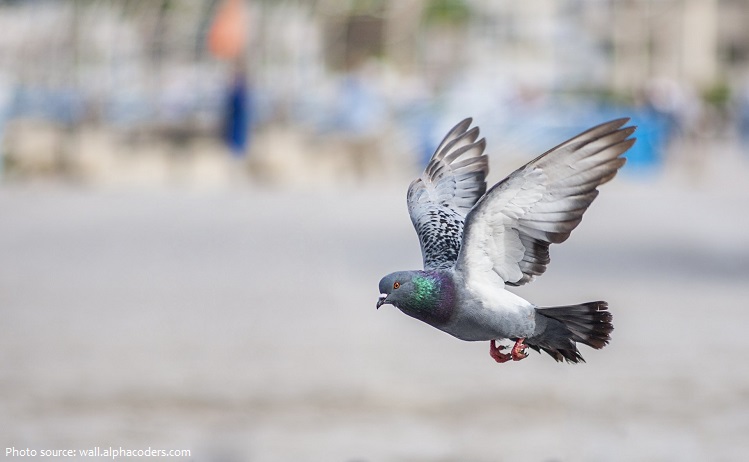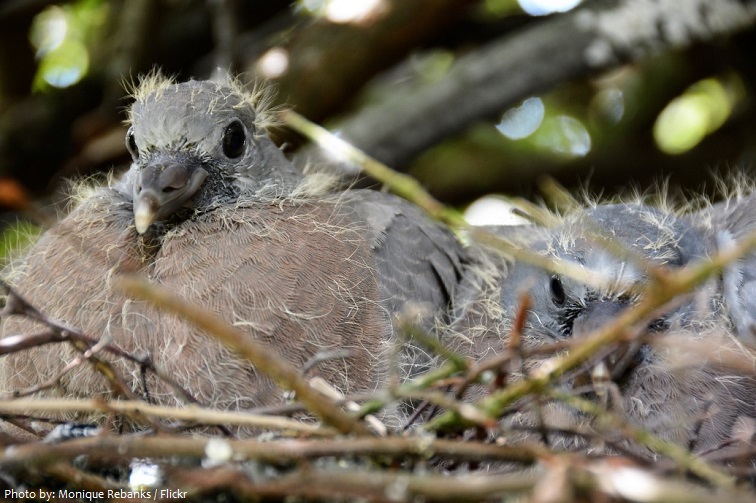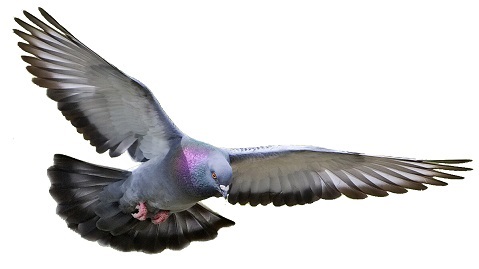The rock dove, rock pigeon, or common pigeon is a member of the bird family Columbidae (doves and pigeons).
In common usage, this bird is often simply referred to as the “pigeon”.
Their combined status as domestic, feral, and wild birds gives them a distinct familiarity to people all over the world.
The rock dove is found in variety of habitats including rocky cliffs, farm land, parks, gardens, cities, and suburbs.
Wild rock doves are native to Europe, North Africa, and southwestern Asia. Feral population are found worldwide, including throughout all of North America.
The term domestic pigeon refers to those individuals, including all the various artificially selected breeds, that live in captivity. It includes about a thousand different breeds.
The rock pigeon is the world’s oldest domesticated bird. Mesopotamian cuneiform tablets mention the domestication of pigeons more than 5,000 years ago, as do Egyptian hieroglyphics. Research suggests that domestication of pigeons occurred as early as 10,000 years ago.
Wild rock doves nest in crevices along rocky seaside cliffs, close to agriculture or open shrub vegetation. Feral pigeons live in old farm buildings in rural areas. In cities, the skyscrapers tend to take the place of their natural cliff surroundings.
A rock pigeon’s lifespan ranges from 3 to 5 years in the wild to 15 years in captivity, though longer-lived specimens have been reported.
The rock dove is 29 to 37 cm (11 to 15 in) long with a 62 to 72 cm (24 to 28 in) wingspan. Weight for wild or feral rock doves ranges from 238 to 380 g (8.4–13.4 oz), though overfed domestic and semidomestic individuals can exceed normal weights.
The wings are large, having 11 primary feathers, and have low wing-loadings; rock doves have strong wing muscles and are among the strongest fliers of all birds; they are also highly manoeuvrable in flight.
Wild rock doves are pale grey with two black bars on each wing, whereas domestic and feral pigeons vary in colour and pattern.
The adult female is almost identical in outward appearance to the male, but the iridescence on her neck is less intense and more restricted to the rear and sides, whereas that on the breast is often very obscure.
Rock doves generally walk or run while bobbing their heads forward and backward. They fly with a steady and direct path. Pigeons are most often seen during daylight, seeking cover at night and in during the heat of the day, according to the climate. They flock while roosting, sunning, and feeding.
The rock dove eats a wide variety of seeds. It may also eat some insects and plants. In cities, rock doves eat seeds, peanuts, bread, pastries, french fries, popcorn and a variety of handouts from humans.
The rock pigeon and other birds in the Columbidae family have a unique way of drinking water. Most birds take a sip of water and then throw back their heads to swallow. The rock pigeon uses its bill like a straw to suck up water!
Pairs may be formed at any point during the year. These pairs are formed for life. Each bird works cooperatively on most aspects of reproduction and young-rearing. The male builds the nest, and the eggs are laid shortly after the nest is finished.
Both males and females incubate the eggs. Eggs hatch approximately 19 days after being laid. The newly hatched squabs (nestlings) has pale yellow down and a flesh-coloured bill with a dark band. For the first few days, the baby squabs are tended and fed (through regurgitation) exclusively on “crop milk” (also called “pigeon milk” or “pigeon’s milk”). The pigeon milk is produced in the crops of both parents in all species of pigeons and doves. The fledging period is about 30 days.
The species is abundant, with an estimated population of 17 to 28 million feral and wild birds in Europe alone and up to 120 million worldwide.
With only their flying abilities protecting them from predation, rock pigeons are a favourite almost around the world for a wide range of raptors. In fact, with feral pigeons existing in almost every city in the world, they may form the majority of prey for several raptor species that live in urban areas.
On the ground, the adults, their young, and their eggs are at risk from feral and domestic cats.
Humans have trained rock pigeons as homing pigeons. They are able to return to the home loft if released at a location that they have never visited before and that may be up to 1000 km (620 miles) away.
The rock pigeon was used in both World War I and II, notably by the Australian, French, German, American, and UK forces. They were also awarded with various laurels throughout, for their service.
Charles Darwin used domestic pigeons as an example of the power of selection to create diverse descendent types from a common ancestor, asserting in his 1859 masterpiece, On the Origin of Species, ‘Great as are the differences between the breeds of the pigeon, I am fully convinced that … all are descended from the rock-pigeon.







